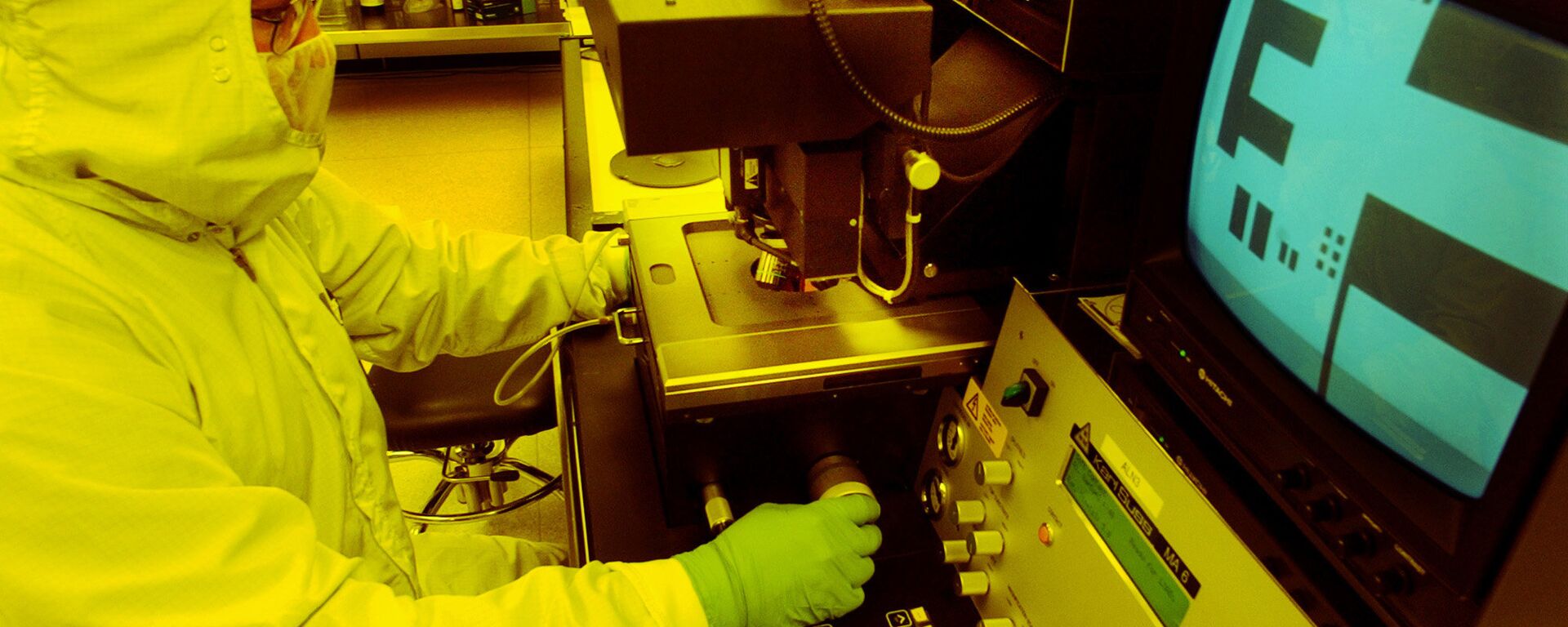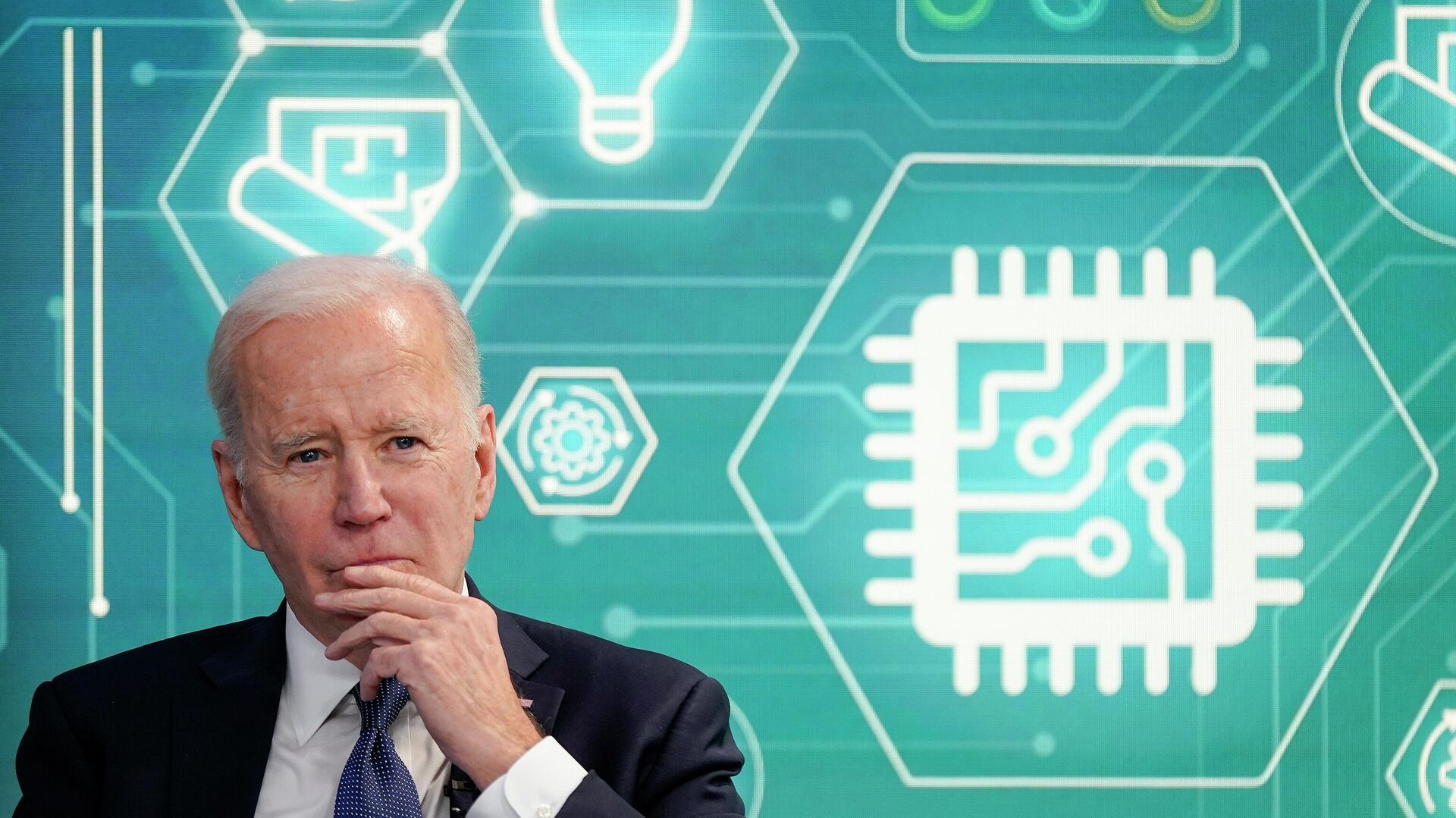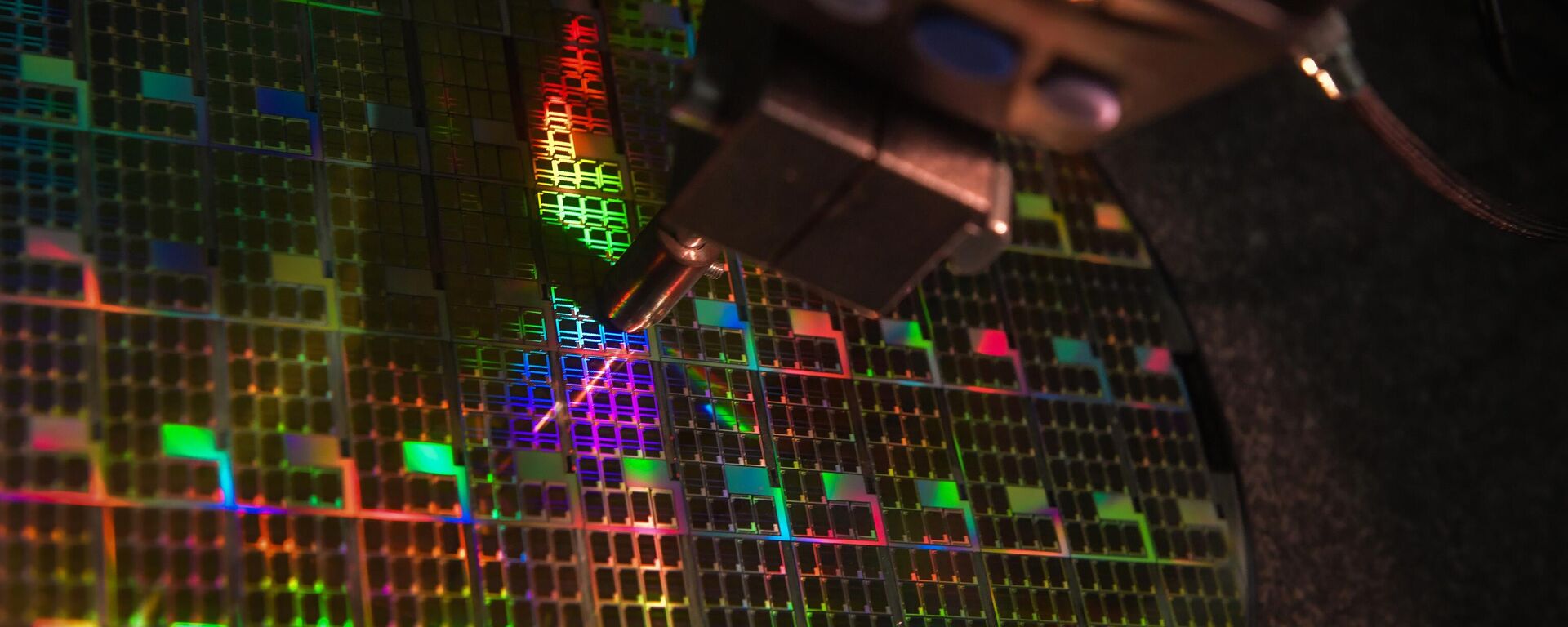https://sputnikglobe.com/20240903/intels-shock-strategic-shakeup-may-doom-bidens-bid-to-reshore-microchip-manufacturing-1120002178.html
Intel’s Shock Strategic Shakeup May Doom Biden’s Bid to Reshore Microchip Manufacturing
Intel’s Shock Strategic Shakeup May Doom Biden’s Bid to Reshore Microchip Manufacturing
Sputnik International
US microchip giant Intel faces what’s been characterized as the most difficult moment in its 56-year history, hiring banksters to advise the company on whether to trim, slash or sell off its manufacturing business. That’s bad news for Washington, which greenlit $280 billion in funding in 2022 toward boosting domestic semiconductor manufacturing.
2024-09-03T16:33+0000
2024-09-03T16:33+0000
2024-09-03T16:33+0000
economy
joe biden
business
warren buffett
taiwan
intel
morgan stanley
amd
https://cdn1.img.sputnikglobe.com/img/07e6/09/01/1100260807_0:161:3071:1888_1920x0_80_0_0_8c56868051685fe609092d64c4398afa.jpg
Intel’s stock has had a rough year-to-date, plummeting nearly 60% since January and falling off a cliff in early August as investors led by billionaire Warren Buffett began a massive selloff which led leading tech stocks to shed nearly $3 trillion in value amid a perfect storm of recession fears, concerns over rising AI-related capital expenditure, and inflation.The shock stock drop shed more light on the difficult situation at Intel, with a flurry of reports beginning late last week citing informed sources revealing that the company is in the “most difficult period in its 56-year history,” looking for strategic advice from the likes of Morgan Stanley and Goldman Sachs, and considering selling off its chip manufacturing capacity.The news carries grave significance for Washington, with Axios pointing out in a report last Friday that Intel isn’t just one of America’s oldest US chipmakers, but “a key national security asset,” signaling the US’s ability (or as it happens, inability) to compete with Taiwan, South Korea, China and other chip-making power players in an increasingly demanding world market for microchips.All eyes are now on Intel’s mid-September board of directors meeting, at which company CEO Pat Gelsinger is expected to present the company’s recovery plan, from cost cuts achieved by shedding “unnecessary businesses,” possibly including US-based programmable chip manufacturing, and even the potential sale of its foundry business to a foreign buyer like TSMC.Intel currently has more than two dozen fab and post-fab sites, most of them in Oregon, Arizona, California, New Mexico, Colorado and Ohio, but also Ireland and Israel. The potential slash in investment threatens to jeopardize the company’s ambitious expansion plans, both domestically and in Germany and Poland, with capital expenditures expected to drop by $10 billion, to $21.5 billion, in 2025. Among the casualties is a reported move to freeze construction of a $32.8 billion factory complex in Magdeburg, Germany.Intel’s troubles are also bad news for the Biden administration specifically, which pumped $8.5 billion into the company’s coffers in March from the 2022 $280 billion CHIPS & Science Act, which includes $39 billion in subsidies for US chip manufacturing, $13 billion for semiconductor research and workforce training, and major tax incentives. Intel also enjoys up to $11 billion in Chips Act loans for modernization and new production.The current administration has made subsidies to microchip manufacturing a key plank of its economic agenda. In addition to a broad array of civilian uses, from computers to vehicles, companies like Intel produce chips for use in military and space applications.The company’s multi-year $100 billion+ US expansion plans fell to the wayside after its stagnant second-quarter earnings ($12.8 billion), sparking massive layoffs of over 15% of its workforce in August. The same month, veteran exec Lip-Bu Tan resigned from Intel’s board, reportedly over differences about the future of the company, and its failure to listen to proposals to make Intel’s contract manufacturing more customer-centric.“Simply put, we must align our cost structure with our new operating model and fundamentally change the way we operate,” Intel chief Pat Gelsinger wrote in a memo in early August while announcing the cuts and firings.A pioneer in microchip manufacturing and the developer of the Intel 4004 – the world’s first commercial microprocessor, in the 1970s, Intel produced the most popular chip of the 80s – the Intel 8088, which ended up powering the IBM PC. Fast forward to the 1990s, and Intel’s engineers developed the revolutionary 32 bit Pentium x86 processors – which were heavily improved upon by former Soviet supercomputer designer Vladimir Pentkovski. In the late 2008, Intel introduced the Intel Core lineup of multicore processers, assuring it superiority over competitors for over a decade before being surpassed by AMD in 2022. A few short years on, Intel has dropped out of the top ten largest global microchip manufacturers entirely by market capitalization.
https://sputnikglobe.com/20240224/china-making-ai-breakthroughs-despite-bidens-sanctions-1116956025.html
https://sputnikglobe.com/20240320/white-house-pledges-85bln-in-funding-for-intels-high-end-chip-manufacturing-1117450491.html
https://sputnikglobe.com/20231202/us-makes-no-advanced-chips-on-its-soil-today---commerce-secretary-1115349442.html
taiwan
Sputnik International
feedback@sputniknews.com
+74956456601
MIA „Rossiya Segodnya“
2024
News
en_EN
Sputnik International
feedback@sputniknews.com
+74956456601
MIA „Rossiya Segodnya“
Sputnik International
feedback@sputniknews.com
+74956456601
MIA „Rossiya Segodnya“
is intel going out of business, will intel sell its chip manufacturing, how and why did intel fall
is intel going out of business, will intel sell its chip manufacturing, how and why did intel fall
Intel’s Shock Strategic Shakeup May Doom Biden’s Bid to Reshore Microchip Manufacturing
US microchip giant Intel faces what’s been characterized as the most difficult moment in its 56-year history, hiring banksters to advise the company on whether to trim, slash or sell off its manufacturing business. That’s bad news for Washington, which greenlit $280 billion in funding in 2022 toward boosting domestic semiconductor manufacturing.
Intel’s stock has had a rough year-to-date,
plummeting nearly 60% since January and falling off a cliff in early August as investors led by billionaire Warren Buffett began a massive selloff which led leading tech stocks to shed nearly
$3 trillion in value amid a perfect storm of recession fears, concerns over rising AI-related capital expenditure, and inflation.
The shock stock drop shed more light on the difficult situation at Intel, with a flurry of
reports beginning late last week citing informed sources
revealing that the company is in the “most difficult period in its 56-year history,” looking for strategic advice from the likes of Morgan Stanley and Goldman Sachs, and considering selling off its chip manufacturing capacity.
The news carries grave significance for Washington, with Axios
pointing out in a report last Friday that Intel isn’t just one of America’s oldest US chipmakers, but “a key national security asset,” signaling the US’s ability (or as it happens, inability) to compete with Taiwan, South Korea, China and other chip-making power players in an increasingly demanding world market for microchips.

24 February 2024, 18:50 GMT
All eyes are now on Intel’s mid-September board of directors meeting, at which company CEO Pat Gelsinger is expected to present the company’s recovery plan, from cost cuts achieved by shedding “unnecessary businesses,” possibly including US-based programmable chip manufacturing, and even the potential sale of its foundry business to a foreign buyer like TSMC.
Intel currently has more than two dozen fab and post-fab sites, most of them in Oregon, Arizona, California, New Mexico, Colorado and Ohio, but also Ireland and Israel. The potential slash in investment
threatens to jeopardize the company’s ambitious expansion plans, both domestically and in Germany and Poland, with capital expenditures expected to
drop by $10 billion, to $21.5 billion, in 2025. Among the casualties is a reported move to freeze construction of a
$32.8 billion factory complex in Magdeburg, Germany.
Intel’s troubles are also bad news for the Biden administration specifically, which pumped $8.5 billion into the company’s coffers in March from the 2022
$280 billion CHIPS & Science Act, which includes $39 billion in subsidies for US chip manufacturing, $13 billion for semiconductor research and workforce training, and major tax incentives. Intel also enjoys up to
$11 billion in Chips Act loans for modernization and new production.
The current administration has made subsidies to microchip manufacturing a key plank of its economic agenda. In addition to a broad array of civilian uses, from computers to vehicles, companies like Intel produce chips for use in
military and
space applications.
The company’s multi-year $100 billion+ US expansion plans fell to the wayside after its stagnant second-quarter earnings ($12.8 billion), sparking massive layoffs of over 15% of its workforce in August. The same month, veteran exec Lip-Bu Tan resigned from Intel’s board, reportedly over differences about the future of the company, and its failure to listen to proposals to make Intel’s contract manufacturing more customer-centric.
“Simply put, we must align our cost structure with our new operating model and fundamentally change the way we operate,” Intel chief Pat Gelsinger wrote in a memo in early August while announcing the cuts and firings.
A pioneer in microchip manufacturing and the developer of the Intel 4004 – the world’s first commercial microprocessor, in the 1970s, Intel produced the most popular chip of the 80s – the Intel 8088, which ended up powering the IBM PC. Fast forward to the 1990s, and Intel’s engineers developed the revolutionary 32 bit Pentium x86 processors – which were
heavily improved upon by former Soviet supercomputer designer Vladimir Pentkovski. In the late 2008, Intel introduced the Intel Core lineup of multicore processers, assuring it superiority over competitors for over a decade before being surpassed by AMD in 2022. A few short years on, Intel has
dropped out of the top ten largest global microchip manufacturers entirely by market capitalization.

2 December 2023, 21:56 GMT





